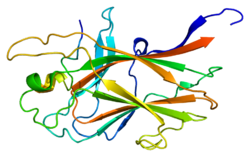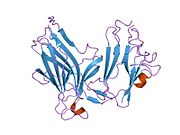EPH receptor B4
| edit |
| EPH receptor B4 | |||||||||||
|---|---|---|---|---|---|---|---|---|---|---|---|
 PDB prikaz baziran na 2bba. | |||||||||||
| Dostupne strukture | |||||||||||
| 2BBA, 2E7H, 2HLE, 2QKQ, 2VWU, 2VWV, 2VWW, 2VWX, 2VWY, 2VWZ, 2VX0, 2VX1, 2X9F, 2XVD, 2YN8, 3ZEW, 4AW5, 4BB4 | |||||||||||
| Identifikatori | |||||||||||
| Simboli | EPHB4; HTK; MYK1; TYRO11 | ||||||||||
| Vanjski ID | OMIM: 600011 MGI: 104757 HomoloGene: 20939 GeneCards: EPHB4 Gene | ||||||||||
| EC broj | 2.7.10.1 | ||||||||||
| |||||||||||
| Pregled RNK izražavanja | |||||||||||
 | |||||||||||
 | |||||||||||
| podaci | |||||||||||
| Ortolozi | |||||||||||
| Vrsta | Čovek | Miš | |||||||||
| Entrez | 2050 | 13846 | |||||||||
| Ensembl | ENSG00000196411 | ENSMUSG00000029710 | |||||||||
| UniProt | P54760 | P54761 | |||||||||
| Ref. Sekv. (iRNK) | NM_004444 | NM_001159571 | |||||||||
| Ref. Sekv. (protein) | NP_004435 | NP_001153043 | |||||||||
| Lokacija (UCSC) | Chr 7: 100.4 - 100.43 Mb | Chr 5: 137.35 - 137.38 Mb | |||||||||
| PubMed pretraga | [1] | [2] | |||||||||
Receptor 4 efrinskog tipa B je protein koji je kod ljudi kodiran EPHB4 genom.[1][2]
Efrinski receptori i njihovi ligandi, efrini, posreduju brojne procese razvića, posebno u nervnom sistemu. Na bazi njihovih struktura i sekvenci, efrini se dele u efrinsku klasu A (EFNA), koja se fiksira na membrani putem glikozilfosfatidilinozitolne veze, i efrinsku klasu B (EFNB), koji su transmembranski proteini. Eph familija receptora se deli u dve groupe na osnovu sličnosti njihovih sekvenci ekstracelularnog domena i njihovog afiniteta vezivanja liganda efrina A i efrina B. Efrinski receptori su najveća podgrupa receptora tirozinske kinazne (RTK) familije. Protein kodiran ovim genom je receptor za efrinske-B članove familije.[2][3]
Reference
- ↑ Bennett BD, Wang Z, Kuang WJ, Wang A, Groopman JE, Goeddel DV, Scadden DT (Jun 1994). „Cloning and characterization of HTK, a novel transmembrane tyrosine kinase of the EPH subfamily”. J Biol Chem 269 (19): 14211–8. PMID 8188704.
- ↑ 2,0 2,1 „Entrez Gene: EPHB4 EPH receptor B4”.
- ↑ Gerety SS, Wang HU, Chen ZF, Anderson DJ (1999). „Symmetrical mutant phenotypes of the receptor EphB4 and its specific transmembrane ligand ephrin-B2 in cardiovascular development.”. Mol. Cell 4 (3): 403–14. DOI:10.1016/S1097-2765(00)80342-1. PMID 10518221.
Literatura
- Flanagan JG, Vanderhaeghen P (1998). „The ephrins and Eph receptors in neural development.”. Annu. Rev. Neurosci. 21: 309–45. DOI:10.1146/annurev.neuro.21.1.309. PMID 9530499.
- Zhou R (1998). „The Eph family receptors and ligands.”. Pharmacol. Ther. 77 (3): 151–81. DOI:10.1016/S0163-7258(97)00112-5. PMID 9576626.
- Holder N, Klein R (1999). „Eph receptors and ephrins: effectors of morphogenesis.”. Development 126 (10): 2033–44. PMID 10207129.
- Wilkinson DG (2000). „Eph receptors and ephrins: regulators of guidance and assembly.”. Int. Rev. Cytol. 196: 177–244. DOI:10.1016/S0074-7696(00)96005-4. PMID 10730216.
- Xu Q, Mellitzer G, Wilkinson DG (2001). „Roles of Eph receptors and ephrins in segmental patterning.”. Philos. Trans. R. Soc. Lond., B, Biol. Sci. 355 (1399): 993–1002. DOI:10.1098/rstb.2000.0635. PMC 1692797. PMID 11128993.
- Wilkinson DG (2001). „Multiple roles of EPH receptors and ephrins in neural development.”. Nat. Rev. Neurosci. 2 (3): 155–64. DOI:10.1038/35058515. PMID 11256076.
- Andres AC, Reid HH, Zürcher G, et al. (1994). „Expression of two novel eph-related receptor protein tyrosine kinases in mammary gland development and carcinogenesis.”. Oncogene 9 (5): 1461–7. PMID 8152808.
- Berclaz G, Andres AC, Albrecht D, et al. (1996). „Expression of the receptor protein tyrosine kinase myk-1/htk in normal and malignant mammary epithelium.”. Biochem. Biophys. Res. Commun. 226 (3): 869–75. DOI:10.1006/bbrc.1996.1442. PMID 8831703.
- Ephnomenclaturecommittee, (1997). „Unified nomenclature for Eph family receptors and their ligands, the ephrins. Eph Nomenclature Committee.”. Cell 90 (3): 403–4. DOI:10.1016/S0092-8674(00)80500-0. PMID 9267020.
- Nikolova Z, Djonov V, Zuercher G, et al. (1998). „Cell-type specific and estrogen dependent expression of the receptor tyrosine kinase EphB4 and its ligand ephrin-B2 during mammary gland morphogenesis.”. J. Cell. Sci. 111 (18): 2741–51. PMID 9718367.
- Tang XX, Brodeur GM, Campling BG, Ikegaki N (1999). „Coexpression of transcripts encoding EPHB receptor protein tyrosine kinases and their ephrin-B ligands in human small cell lung carcinoma.”. Clin. Cancer Res. 5 (2): 455–60. PMID 10037197.
- Dalva MB, Takasu MA, Lin MZ, et al. (2001). „EphB receptors interact with NMDA receptors and regulate excitatory synapse formation.”. Cell 103 (6): 945–56. DOI:10.1016/S0092-8674(00)00197-5. PMID 11136979.
- Wilson MD, Riemer C, Martindale DW, et al. (2001). „Comparative analysis of the gene-dense ACHE/TFR2 region on human chromosome 7q22 with the orthologous region on mouse chromosome 5.”. Nucleic Acids Res. 29 (6): 1352–65. DOI:10.1093/nar/29.6.1352. PMC 29746. PMID 11239002.
- p
- r
- u
|










